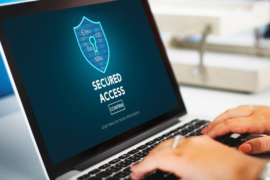Are your POS systems safe from unauthorized access? Access control procedures in your point-of-sales (POS) systems are no longer optional—they have become a necessity for any organization that intends to prosper in the long term.
You can enhance your security posture by protecting sensitive data and preventing illegal access to your POS system. In this article, we’ll focus on discussing the main steps you need to take for effective access control practices:
- Define user roles and levels
- Set up access rights and permissions
- Monitor user activity
- Assess and update access rights on a regular basis
- Train employees on access control procedures
Let’s find out how these measures can help protect your organization from potential threats while also keeping your POS systems efficient.
Defining user roles and levels
By specifying user roles in your POS system, you guarantee that only authorized employees have access to certain data and features – especially when credentials are securely managed via a password manager. In this way, the POS providers can assign more specific rights to the users, which increases the security of the system.
Establish different user roles and assign them
Before anything else, identifying disparate user types and determining their limitations of access is a necessary first step. To start, you should evaluate what the POS system users require and what their function is, including cashiers, supervisors or system administrators.
Each user type comes with a unique collection of permissions. After the roles have been defined, the next step is to decide to which extent each role should have access to the system. The aim is to ensure that everyone can complete their tasks efficiently. Access control measures vary according to different levels of complexity of various duties such as basic checkout processes and sophisticated management operations.
Benefits of setting user roles
There are several advantages that come with creating user roles. First and foremost, by limiting the access rights granted to a specific user, the risk of any unauthorized entry into the system is lowered. By restricting access to vital information, the chances of security breaches are reduced. Additionally, modifying access levels creates a more controlled and safe work environment where data integrity is maintained, while internal threats are minimized.
Setting up and managing user permissions
For the point-of-sale (POS) security, access rights are critical as they allow you to define the degrees of access and permission for each user based on their position within the company.
The different levels of access and permissions
There are four variables to ensure the confidentiality, integrity and availability of sensitive POS system data and customer information: read, write, execute and delete rights. To give an example, a cashier may only have read/write access to sales data in the POS system, while only an admin would be able to delete data.
Setting up and managing user permissions
As usual, preparation is key. Combined with close communication with the POS provider this ensures that permissions are in line with company policy and security requirements. When configuring and managing user permissions there are three essential components to consider:
- Regularly view and update permissions: Every organization experiences regular changes, including shifts in staff responsibilities. Therefore, in order to reflect organizational changes digitally, it’s essential that user permissions are reviewed on a regular basis—or even better, on a strictly scheduled basis.
- The POS provider’s role: The POS provider’s responsibility is to assist businesses in establishing and maintaining user permissions in accordance with best practices. Additionally, they ensure system security and offer support to help businesses smoothly adapt to any changes.
- Keeping your software up to date: To maintain the security and efficiency of a POS system, it’s important to consistently update your software.
Magestore POS allows owners to access and manage their POS data to ensure private data policy and security.
Monitoring and auditing user activity
To identify potential security breaches and ensure compliance with the established access control policies, you need to monitor and audit user activity within a POS system.
Putting monitoring and auditing procedures in place
It’s possible to use specific monitoring and auditing processes to obtain a comprehensive log of every contact and transaction done within the system. To do that, specialized software can be employed to maintain the security of point-of-sale systems while monitoring user activity and generating audit logs for review. One valuable solution is implementing AI fraud detection software that can help identify unusual behaviors and unauthorized activity in real time. These tools not only alert you to potential fraud attempts but also enhance overall transaction integrity by analyzing patterns that human oversight might miss.
This method provides valuable benefits to your organization. First, you can detect and stop suspicious trends or behaviors early enough to avoid potential security breaches like fraud or unauthorized access. Secondly, utilizing these tools ensures that your organization is compliant with industry regulations and standards, as all transactions are recorded and can be traced if necessary.
Such measures prevent security breaches from occurring; besides, they ensure that operations are more efficient overall thus enabling smoother and more effective security processes and reactions.
Regularly reviewing and updating access rights
Regularly reviewing and updating access rights is an important aspect of maintaining point-of-sale (POS) security and helps to eliminate possible vulnerabilities within the system.
Periodic evaluation permissions
To ensure that access rights are aligned with current operational and security requirements, periodic evaluation and adjustment of permissions in a POS system are necessary.
Initially, an evaluation is carried out to find out the access that has been assigned to various users of the system. Afterward, a comparison of those access rights with respect to all user roles and responsibilities is conducted to find out if there are any discrepancies or redundant access levels.
Immediate adjustment if needed
In case of any discrepancies, it’s important to make an immediate change. The system administrator can make necessary changes anytime they note abnormalities so that users have the right amount of access that enables them to do their work efficiently while substantially cutting down on the chances of unauthorized access or data breaches.
To ensure that only authorized personnel have access to POS systems, it’s essential to quickly block access for users who change roles or leave the organization.
Training employees on access control
A team is never stronger than its weakest link. Therefore, to preserve customer trust and the security of the POS system, it’s important that every staff member receives the training they need in order to understand the importance of the policies and know how to adhere to them.
How to educate staff on access security
It’s recommended that thorough training sessions be offered that cover the fundamentals of access control as well as particular POS system operations. Among these instructional techniques are:
- Using the POS system practically,
- Role-playing simulated security breaches, and
- Holding regular refresher courses for employees on current security measures.
To make sure that employees can use the system to achieve maximum security, it’s important for POS suppliers to participate in staff training sessions. When trained, they can quickly identify and rectify possible threats thus preventing unauthorized access while safeguarding sensitive information.
Frequently Asked Questions
What are access control policies in a POS system?
Access control policies are the rules that govern who can use the POS system and how. In other words, these policies determine who has permission to access the system, what actions they can take, and what data they can view or change.
What are some common access control policies used in a POS system?
Access control policy examples used regularly include role-based access control, password policies, and multi-factor authentication among others. The purpose of these is to limit system access only to authorized users.
How can I determine the appropriate access control policies for my POS system?
The appropriate access control policies for your POS system will depend on the specific needs and requirements of your business. It’s recommended to consult with a security expert or IT professional to assess your system and determine the best policies to implement.
Do access control policies only apply to external threats?
No, access control policies also apply to internal threats, such as employee errors or intentional misuse of the system. It’s important to have strict policies in place to prevent unauthorized access and misuse by employees.
What should I do if I suspect a security breach in my POS system?
If you suspect a security breach in your POS system, it’s important to take immediate action. This may include changing passwords, disabling user accounts, and notifying the appropriate authorities. It’s also important to assess the damage and take steps to prevent future breaches.




